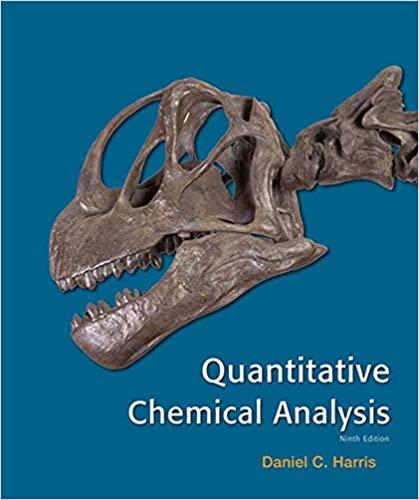Question
When performing the extraction with the separatory funnel, which solvent is the bottom layer and why? EXPERIMENTAL 1. Obtain the corked flask set aside after
When performing the extraction with the separatory funnel, which solvent is the bottom layer and why?
EXPERIMENTAL
1. Obtain the corked flask set aside after experiment 1. Carefully decant (pour off) the liquid into the appropriately labelled waste container, keeping the crystals in the flask. Add 10 mL of methanol to the crystals and suspend and break the mass up into individual crystals with a stirring rod.
2. Using a small Büchner funnel and filter flask, clamped properly to the retort stand, collect the crystals by vacuum filtration. Wash any remaining crystals out of the flask with a small amount of the filtrate and rinse the crystals on the funnel with 10 mL of fresh methanol. Spread the crystals on paper to air-dry, then weigh the product and calculate the percentage yield of the (-)-α-phenylethylammonium hydrogen (+)-tartrate salt.
3. Place the crystalline salt product in a 125 mL Erlenmeyer flask. Add 30 mL of 2 M aqueous NaOH solution. Swirl the mixture until all of the crystals have dissolved. You may notice the water turning cloudy or oily; this is normal (what is this due to?)
Note: The next steps require a separatory funnel. Its use will be demonstrated by your TA.
4. Transfer the aqueous NaOH-salt mixture to the separatory funnel using a plastic funnel (to minimize spillage). Rinse the flask with 10 mL of dichloromethane. Add this rinse to the separatory funnel. Allow sufficient air space in the funnel to mix the liquids (as a general rule, never fill a separatory funnel more than two-thirds to three-quarters full).
5. Stopper the funnel. Lift the separatory funnel out of its ring support and hold it with both hands to prevent the stopper from falling out. Hold the rounded body in one hand, near the stopcock so that you can open and close the stopcock quickly to release pressure, but keep a finger of the other hand over the stopper at all times. 30
6. Invert the funnel (so that the stem points upwards and the airspace is at the stopcock end). With the stem aimed well away from yourself and others, immediately open the stopcock to release any pressure arising from the mixing of the two solvents. Most organic solvents are fairly volatile and their vapour pressure causes buildup of pressure in the funnel. When venting a funnel in this way, never point the stem towards yourself or your neighbours. Be sure to always wear your safety glasses in a lab full of separatory funnels.
7. After the first venting, close the stopcock, swirl the inverted funnel for a few seconds, and then vent it again. If excessive pressure build-up is evident, repeat the swirling-venting process until the pressure build-up is negligible. Then, and only then, the funnel may be shaken vigorously for about 2 minutes with venting every 20 seconds or when pressure builds. At the end of the shaking, vent the funnel again, return it to the ring support, remove the stopper, and allow the aqueous and organic layers to separate.
8. To withdraw the dichloromethane phase (and hence your amine), you must first know which layer is the organic layer. As a general rule, the denser liquid is the layer on the bottom. Most organic solvents are less dense than water, with the exception of solvents containing halogen atoms. Withdraw the dichloromethane layer into a clean and dry 50 mL Erlenmeyer flask, leaving the aqueous layer in the separatory funnel.
9. Extract this aqueous phase twice more with 5 mL portions of dichloromethane and combine these extracts with the first in the Erlenmeyer (repeat steps 5-8 with fresh solvent each time). Once all the extractions are finished, the aqueous solution in the separatory funnel can be discarded into the appropriate waste container.
10. To dry the dichloromethane extract, Add about 1 gram of anhydrous potassium carbonate (don’t measure this mass exactly) to the Erlenmeyer flask and swirl, then let it stand for a few minutes. When the dichloromethane is dry, it will appear clear (perhaps with a yellow colour) and the potassium carbonate will be easily settled on the bottom of the flask. If this is not the case, you may need to add more potassium carbonate.
11. Weigh a clean and dry 50 mL beaker containing 1 or 2 boiling stones.
12. Filtering the dichloromethane solution into the pre-weighed beaker using a small cotton plug fitted at the constriction of a plastic funnel. Rinse the cotton plug with 5 mL of fresh dichloromethane. 31
13. Place the beaker onto a steam bath to remove the dichloromethane. It will be completely removed when the solution stops boiling, leaving behind the free liquid amine.
14. Remove the beaker from the steam bath, let it cool to room temperature then weigh the beaker again. The weight thus gained is the weight of the amine that it contains. Calculate the percent yield of the isolated amine and proceed with the polarimeter measurement.
15. The laboratory technicians will assist you in using the polarimeter. Record the observed optical rotation from your amine sample and convert that into a standard optical rotation on your report sheet. This will allow you to calculate the optical purity of your amine product.
Step by Step Solution
There are 3 Steps involved in it
Step: 1
When performing the extraction with a separatory funnel the solvent that form...
Get Instant Access to Expert-Tailored Solutions
See step-by-step solutions with expert insights and AI powered tools for academic success
Step: 2

Step: 3

Ace Your Homework with AI
Get the answers you need in no time with our AI-driven, step-by-step assistance
Get Started


